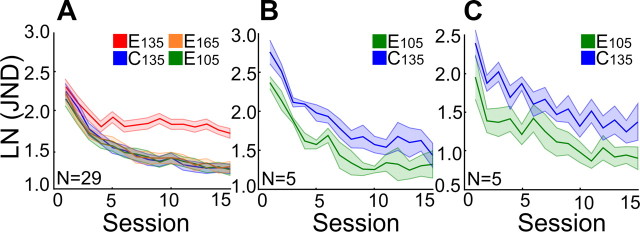Figure 5.
Stimulus dependency of behavioral interference. A, Interference is asymmetric. P2 training of E105 and E165 delays P1 training of E135, but not vice versa. Learning curves for E105 and E165 are indistinguishable from learning curves for C135. B, Data of the five subjects from the Δ0 h P1–P2 interval on the C135 and E105 conditions from the original experiment. C, Data for the same five subjects after extra training on new C135 and E105 conditions in the new, control experiment in which training at the 105° reference orientation could not have suffered from interference. To analyze whether the E105 performance was comparable in original (B) and control (C) experiments, a repeated-measures ANOVA [Experiment (original, control) × Condition (C135, E105) × Session (15)] was carried out. This analysis indicated that the Condition × Experiment interaction was not significant (F(1,8) = 1.501, p = 0.255). Thus, the performance on the E105 condition was similar in both experiments, thereby supporting the conclusion that training at the 105° and 165° reference orientations was not interfered with by training at the 135° reference orientation in the same visual field position.

